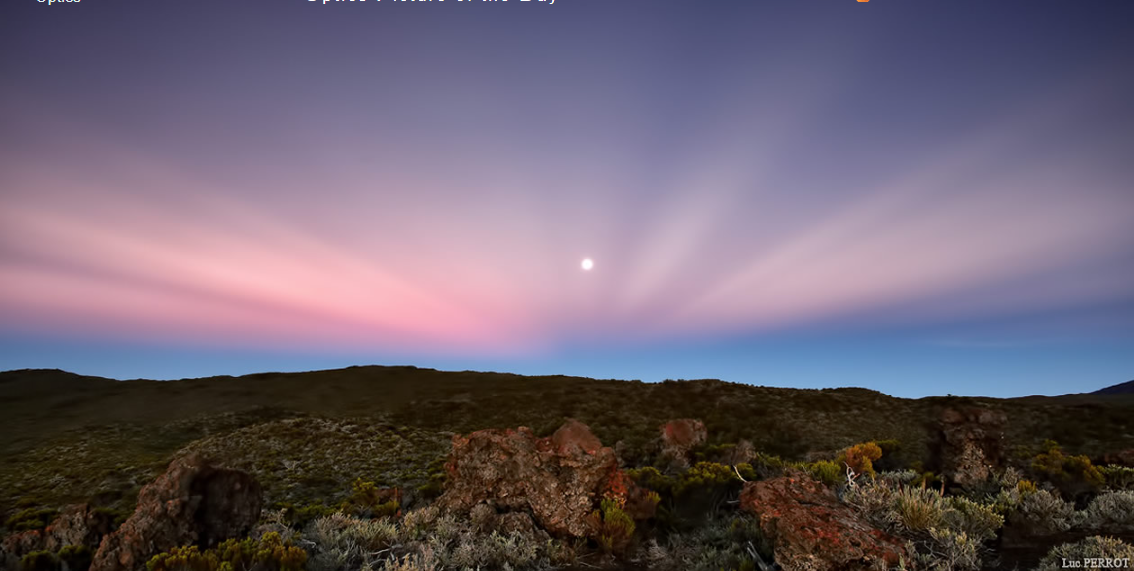Antisolar Rays & Moon - OPOD
Antisolar Rays & Moon - A Phenomenon Worth Exploring
When it comes to atmospheric optics, one intriguing phenomenon that often captivates our attention is the presence of antisolar rays. These rays, sometimes misleadingly referred to as anticrepuscular rays, are not just a figment of our imagination. They exist in space and can be observed and studied. In this article, we will delve into the details of antisolar rays and explore their relationship with the rising moon.
Antisolar rays are characterized by bright sky areas between long dark shadows cast by clouds in the opposite hemisphere of the sky. Unlike many other atmospheric optical phenomena, such as rainbows or halos, these rays are not caused by the scattering or refraction of light. Instead, they are parallel tubes of dark air that appear to converge towards the antisolar point solely due to the effect of perspective.
While antisolar rays can be observed in various parts of the sky, their connection with the moon adds an extra layer of fascination to the phenomenon. If we closely examine the position of the almost full moon in relation to the converging rays, we might notice that they are not perfectly aligned. This is because the moon's orbit is tilted approximately 5 degrees compared to the plane of Earth's orbit around the sun.
Due to this tilt, the full moon can deviate several degrees from the antisolar point. It is worth noting that if the full moon coincides with the intersection of the two orbital planes, a lunar eclipse occurs, creating a breathtaking celestial spectacle. So, while the moon may not always align precisely with the converging antisolar rays, its presence in the sky adds a captivating element to this atmospheric optical phenomenon.
To truly appreciate and understand antisolar rays and their connection with the moon, it is important to explore their occurrence in different locations and atmospheric conditions. One such instance was captured by Luc Perrot's lens on January 15th, 2014, near the volcano Piton de la Fournaise on Reunion Island in the Indian Ocean. The photograph showcases the mesmerizing interplay between the rising moon and the bright sky areas amidst the dark shadows cast by clouds.
To further expand our knowledge of antisolar rays and their relationship with the moon, scientific studies and observations are crucial. By analyzing the behavior of these rays in various atmospheric conditions and geographical locations, we can gain valuable insights into the complex interplay of light, perspective, and celestial objects.
In conclusion, antisolar rays and their connection with the rising moon offer a captivating glimpse into the wonders of atmospheric optics. These parallel tubes of dark air crossing the sky, converging towards the antisolar point, create a mesmerizing spectacle that challenges our understanding of light and perspective. While the moon's position may not always align perfectly with the converging rays, its presence adds an extra layer of intrigue to this phenomenon. By continuing to explore and study antisolar rays and their relationship with celestial objects, we can unravel the mysteries of our atmosphere and deepen our appreciation for the beauty that surrounds us.

Antisolar Rays & Rising Moon ~ Taken by Luc Perrot (Photography) close to sunset on 15th January '14 and of course looking eastwards away from the sun. Location: Reunion Island in the Indian Ocean and near the volcano Piton de la Fournaise.
©Luc Perrot, shown with permission
The rays are bright sky between the long dark shadows cast by clouds in the opposite sky hemisphere.
Unlike most sky optics, antisolar rays (also misleadingly called anticrepuscular rays) are real, they exist in space, they can be flown around or through. They are parallel tubes of dark air crossing the sky that appear to converse towards the antisolar point purely by perspective.
Why is the almost full moon not where the rays converge? The moon's orbit is tilted ~5° to that of the plane of Earth's orbit around the sun. The full moon can therefore be several degrees from the antisolar point. If the full moon occurs at the intersection of the two orbital planes there is a lunar eclipse.
Note: this article has been automatically converted from the old site and may not appear as intended. You can find the original article here.
Reference Atmospheric Optics
If you use any of the definitions, information, or data presented on Atmospheric Optics, please copy the link or reference below to properly credit us as the reference source. Thank you!
-
<a href="https://atoptics.co.uk/blog/antisolar-rays-moon-opod/">Antisolar Rays & Moon - OPOD</a>
-
"Antisolar Rays & Moon - OPOD". Atmospheric Optics. Accessed on November 26, 2024. https://atoptics.co.uk/blog/antisolar-rays-moon-opod/.
-
"Antisolar Rays & Moon - OPOD". Atmospheric Optics, https://atoptics.co.uk/blog/antisolar-rays-moon-opod/. Accessed 26 November, 2024
-
Antisolar Rays & Moon - OPOD. Atmospheric Optics. Retrieved from https://atoptics.co.uk/blog/antisolar-rays-moon-opod/.